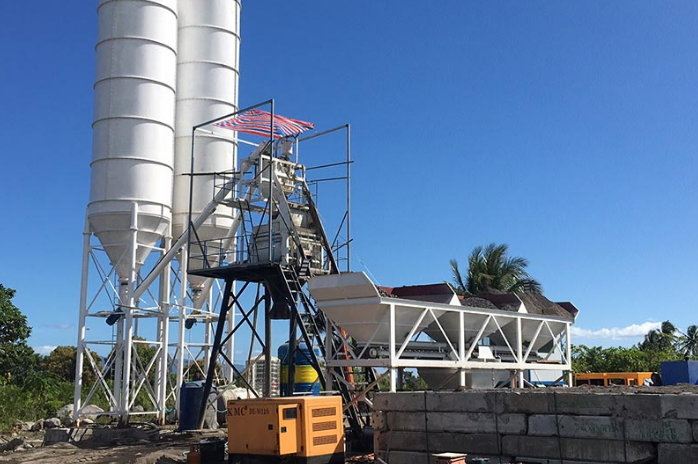The Different Types of Concrete Batching Plants and Their Uses
Concrete batching plants are essential in the construction industry, producing concrete on a large scale to ensure projects are completed efficiently and on time. These machines mix sand, cement, water, and other aggregates to create concrete, with different types of plants designed for specific purposes.
Concrete is a fundamental material used in building foundations, walls, floors, and other structures. The quality of concrete directly impacts the durability and safety of a building. Therefore, using high-quality concrete requires the right type of batching plant.
In this blog post, we will explore the various types of concrete batching plants and their uses, along with the advantages and disadvantages of each, to help you select the best option for your construction project.
Stationary Concrete Batching Plants
Stationary concrete batching plants are large machines permanently installed at construction sites. These plants are designed to produce high volumes of concrete and are commonly used for large-scale construction projects. Due to their stationary nature, they cannot be easily relocated. The plants consist of various components, including mixers, cement silos, and conveyor belts, among others.
Advantages and Disadvantages of Stationary Concrete Batching Plants:
Advantages:
- Capable of producing large quantities of concrete in a short time
- Ensures consistent and high-quality concrete through advanced mixing technology
- Can be fully automated, minimizing the need for manual labor
- Customizable to meet specific construction requirements
Disadvantages:
Expensive to install and maintain
Not easily movable, making them unsuitable for small construction projects
Require a large amount of space for installation
Examples of Projects that Require the Use of Stationary Concrete Batching Plants:
Stationary concrete batching plants are typically used for large construction projects that require a continuous supply of high-quality concrete. Examples of such projects include:
- Construction of bridges, highways, and airports
- Construction of large commercial and residential buildings
- Construction of dams and power plants
- Construction of tunnels and underground structures
Mobile Concrete Batching Plants
Mobile concrete batching plants are compact machines designed for easy transportation between construction sites. Ideal for small and medium-sized projects, these plants consist of components like mixers, cement silos, and conveyor belts. Their ability to produce concrete on-site makes them highly convenient and cost-effective.
Advantages and Disadvantages of Mobile Concrete Batching Plants:
Advantages:
- Easily transportable between sites, reducing transportation costs
- Quick and simple setup, minimizing installation time
- On-site concrete production eliminates the need for external transportation
- Well-suited for small and medium-sized construction projects
Disadvantages:
- Limited capacity to produce large volumes of concrete
- Unsuitable for large-scale construction projects
- Mobility requires frequent maintenance
Examples of Projects that Require the Use of Mobile Concrete Batching Plants
Mobile concrete batching plants are perfect for small and medium-sized construction projects needing a continuous concrete supply. Examples include:
- Road and bridge repair projects
- Residential and commercial building construction
- Small-scale concrete production for construction needs
- Remote construction sites where transporting concrete is difficult
Ready Mix Concrete Batching Plants
Ready mix concrete batching plants produce concrete at a central location and transport it to the construction site. These plants, typically located near construction sites, can produce large volumes of concrete quickly. They consist of components such as mixers, cement silos, and conveyor belts.
Advantages and Disadvantages of Ready Mix Concrete Batching Plants:
Advantages:
- Capable of producing large volumes of concrete in a short time
- Consistent and high-quality concrete achieved through advanced mixing technology
- Reduces transportation costs as concrete is produced near the site
- Customizable to meet specific construction requirements
Disadvantages:
- High installation and maintenance costs
- Unsuitable for small-scale construction projects
- Limited control over the quality of raw materials
Examples of Projects that Require the Use of Ready Mix Concrete Batching Plants:
Ready mix concrete batching plants are best suited for large-scale construction projects requiring a continuous supply of high-quality concrete. Examples include:
- Construction of high-rise buildings
- Large commercial and industrial buildings
- Infrastructure projects like airports and seaports
- Road and highway construction
Compact Concrete Batching Plants
Compact concrete batching plants are small, portable machines designed to produce concrete in limited volumes. They are ideal for small construction projects requiring a manageable amount of concrete. These plants consist of components such as mixers, cement silos, and conveyor belts.
Advantages and Disadvantages of Compact Concrete Batching Plants:
Advantages:
- Highly portable and easily transportable between sites
- Perfect for small construction projects with limited concrete needs
- Quick and simple to install and set up
- Low maintenance requirements due to their compact size
Disadvantages:
- Limited production capacity, unsuitable for large-scale projects
- Less control over the quality of raw materials
- Higher cost per unit of concrete produced
Examples of Projects that Require the Use of Compact Concrete Batching Plants:
Compact concrete batching plants are ideal for small-scale construction projects, such as:
- Residential building construction
- Small commercial building projects
- Sidewalk and small road construction
- Small bridges and culverts construction
Importance of Choosing the Right Type of Concrete Batching Plant for Your Construction Project
Choosing the right concrete batching plant is crucial for the success of any construction project. An incorrect choice can result in delays, cost overruns, and substandard concrete quality. Key factors to consider include project size, required concrete volume, construction site location, and raw material quality. Selecting the appropriate plant ensures efficient and cost-effective production of high-quality concrete, ultimately contributing to the project's success.














